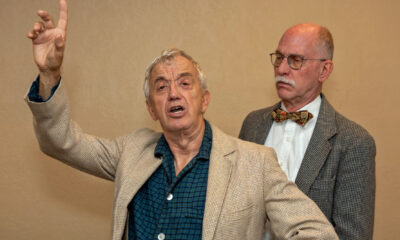Comm Voice
Roy Peter Clark: What is a man? The big question that needs an answer

Overwhelmed by news and commentary about “toxic masculinity,” I’ve decided to share a short piece of writing I created about 10 years ago.
It was never intended for publication. It was a school exercise for a group of about 30 young men – ages 11 to 16 – in a Poynter Institute program called The Write Field. Led by the Rev. Kenny Irby, one of America’s outstanding photojournalists and pastor of the Historic Bethel AME Church, it was designed to help young men build their literacy skills and their characters.
Most but not all of the students are Black, supported over the years by a group of magnificent mentors, including professionals from the school system, news organizations, and the police department. The first students in the program have now graduated from high school and college with more success than many of their peers, and a devotion to education, citizenship and social justice that is inspiring.
I am a teacher of reading, writing, and public speaking. Each year I join the Write Field with the goal of helping these young men find their authentic voices. When they enter the program, many are hesitant to express themselves in any form. So as not to stand out, they speak softly. They fear criticism of their grammar, their way of speaking, or their reading skills. So we practice.
They write something, and then read it in small groups. They are encouraged to speak up. They are praised, even just for their effort. They are working toward a moment when they may be asked to read in front of a large group of teachers, family members, sponsors, even dignitaries such as coach Tony Dungy, journalist Byron Pitts, or film producer William Packer.
“Say it loud and proud,” said the Rev. Irby, one of his many exhortations of encouragement that has been repeated by the current directors Ernest Hooper and Demorris Lee.
I teach the young men to stand tall, not to hide their faces, not to speak too quickly; how to pause, how to look the audience in the eye, how to project their voices to the grandmother sitting in the back row.
They needed a common text, I thought, with which to practice. But which one? Maybe the Gettysburg Address, Dr. King’s “I Have a Dream” speech, a soliloquy from an August Wilson play, or the opening to the musical Hamilton. We have done all of these. But I felt the need to create something distinctive, something just for them.
The result was a 142-word text entitled “What is a man?” Designed as an exercise in public speaking, it has grown into something more, perhaps a potential antidote to that poison of toxic masculinity. Here is what I wrote, what has now been read in St. Petersburg countless times:
What is a man?
A man stands up straight and will not bow before tyrants.
He confronts the world in all its confusion, looking for answers from his childhood to his grave.
He does not use others, especially women, for his own needs, but acts to help others with service and respect.
A man is at his best when he acts not out of his obvious strength, but when he acts despite his weakness.
He uses his mind, his body, his soul, his love, his faith, his hope, his good works, all the gifts that have been given to him to enrich the quality of life in his school, his family, his workplace, his community, his country, his world.
I embrace not just the man I am now, but the one I want to be.
What is a man? Look at me.
It has been fascinating to watch students – some with childlike voices, others with manly baritones – express this declaration of manhood. It is almost as if they grow taller as these words crack the air. In a short time, some students will recite it without looking at the page, the repetition and performance practice branding it on their memories.
On more than one occasion I have asked myself, “What is this thing I have written?” Is it a poem, a creed, a pledge, a manifesto? Whatever it is, it carries an emotional impact. A former colleague at Poynter, Sara Quinn, overheard a student practicing it, and the power of it moved her to tears.
I am sharing this to let you know that there are many men and women out there working hard at turning boys into men. If you are one of these good folks – working in Big Brothers or a church group or a Boys Club – or if you are just trying to raise a good and responsible young man in your own household – feel free to use this document as a tool.
Read it yourself. Read it to each other. Publish it in your social network. We know it’s not perfect. Some Write Field students have suggested additions and revisions. Write your own declaration. Illustrate it. Write a rap version. Turn it into a play.
My first draft of this essay began with a long list of examples of where American men have gone wrong. You don’t need it. You could write your own list. Let’s prepare for a day when we can post another list, one where the answer to the question “What is a man?” reveals, not disappointment and despair, but virtue and hope.
What is a man? Don’t look at me, dear reader. Look, instead, at the young men I have had the honor of teaching.







